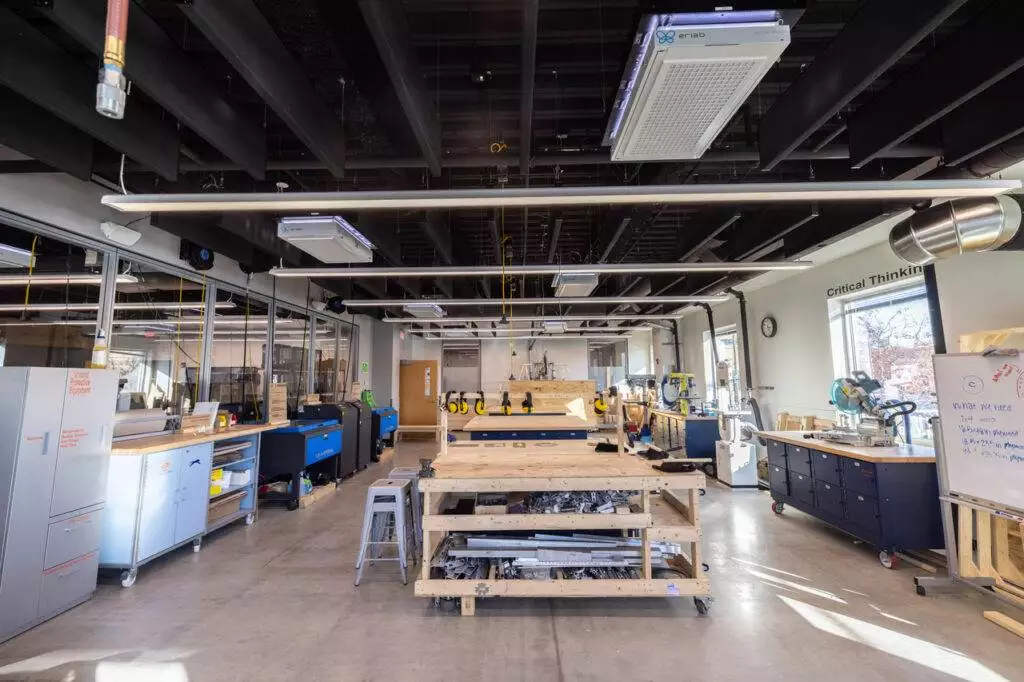Blogs & News
- Category: Laboratory
- DATE: May 7, 2024
Creating Engaging Educational Spaces: Best Practices in School Laboratory Design
In the quest for educational excellence, the design of school laboratories plays a pivotal role in shaping the learning experiences of students. We understand that a well-designed laboratory is more than just a room filled with tables and equipment; it’s a dynamic environment that inspires scientific curiosity, fosters collaboration, and facilitates hands-on learning. With a century of experience in creating exceptional spaces, we’re here to share best practices in school laboratory design that cater to the evolving needs of educational institutions.
Aligning Design with Educational Goals
The foundation of an effective lab design lies in its alignment with the curriculum and educational objectives. Laboratories should be versatile to accommodate various teaching methods and learning styles, ensuring that students can explore, experiment, and engage with the subject matter deeply. By integrating flexible furniture and adaptable spaces, we empower educators to deliver lessons that resonate with each and every student.
In a school setting, the need for flexibility in lab design is paramount due to the diverse range of scientific subjects typically taught. For instance, a biology lab might require movable tables and sinks to facilitate hands-on experiments, dissections, and group activities. Storage cabinets with adjustable shelves are essential for accommodating specimens, microscopes, and other equipment.
In contrast, a chemistry lab necessitates robust countertops resistant to chemical spills and heat, along with fume hoods for safety during experiments involving volatile substances. Mobile storage carts equipped with locking mechanisms are ideal for storing chemicals and lab supplies securely while allowing for easy reconfiguration of the space for different experiments.
Physics labs often benefit from open floor plans that enable the setup of various equipment configurations for experiments on motion, optics, and electricity. Adjustable-height tables or benches accommodate students of different heights and facilitate collaborative work on projects requiring assembly or construction.
Environmental science labs may require specialized equipment for soil and water testing, necessitating designated workstations with easy access to utilities such as water and gas lines. Flexible storage solutions, such as modular shelving units or mobile carts, accommodate samples, field equipment, and research materials, allowing for seamless transitions between indoor and outdoor activities.
Incorporating flexibility into lab design not only caters to the diverse needs of different scientific disciplines but also fosters a dynamic learning environment where students can actively participate in inquiry-based investigations and collaborative projects. By embracing versatility in furniture and storage capabilities, school laboratories become vibrant hubs of scientific exploration and discovery, empowering both educators and students to achieve their educational goals effectively.
Prioritizing Safety and Innovation
Safety is paramount in laboratory settings of all kinds. Integrating advanced safety features, from proper ventilation systems to emergency wash stations, ensures that students and teachers can focus on learning without concerns for their well-being. Through innovative materials and smart design choices, we create environments that are safe and conducive to exploration and discovery.
Lab furniture and equipment play a crucial role in maintaining a safe environment for scientific experimentation. When selecting furniture and equipment, prioritizing safety considerations is essential. Make sure to work with your suppliers if you need chemical-resistant countertops, a specific type of fume hood based on what the lab is being used for, safety showers, eye wash stations, and safety cabinets or storage containers for specific chemicals and materials.
Cultivating Collaboration and Interaction
Today’s educational paradigms emphasize teamwork and collaboration. School laboratory designs must facilitate these interactions, incorporating areas for group work and integrating technology that encourages students to share ideas and work together on projects. These spaces not only support the current curriculum demands but also prepare students for the collaborative nature of the modern workforce.
Embracing Technology and Sustainability
In an era defined by rapid technological advancement, laboratories must be equipped to provide students with a hands-on understanding of cutting-edge technologies. We offer the latest state-of-the-art fume hood technology, providing students with the opportunity to work with the same equipment utilized in higher education and research settings. This ensures that students are thoroughly prepared for their future scientific pursuits.
Sustainability also plays a crucial role in school laboratory design. By offering products that are LEED green building certified materials and promoting energy-efficient practices, we create laboratories that teach students the importance of environmental stewardship, embodying lessons that extend beyond the classroom walls.
Ensuring Accessibility for All
Inclusivity must be at the heart of school lab designs, as every student deserves equal access to learning opportunities. Adjustable laboratory workstations, flexible furniture, and accessible technology ensure that all students, regardless of physical ability, can participate fully in the learning experience.
Designing for Aesthetics and Functionality
The physical environment significantly impacts students’ ability to learn and teachers’ ability to instruct. Our product offerings strike a balance between aesthetic appeal and functional necessity, helping to create spaces that are bright, inviting, and conducive to scientific discovery and exploration.
Preparing for the Future
When you are designing educational laboratories, we not only focus on current needs but also anticipate future trends. Our approach involves helping to create adaptable spaces that can evolve with technological advancements and changing educational paradigms. By staying ahead of the curve, we ensure that the laboratories we assist in designing today remain relevant and effective for years to come.
With a century of expertise in the construction industry, we’re uniquely positioned to master the art of school laboratory design that combines safety, functionality, aesthetics, and technology. Let us help you shape the minds of the future by helping you design spaces where education comes to life. Contact our team at [email protected] to start your school lab project today.
recent blogs



GET STARTED
LET’S TALK ABOUT YOUR PROJECT TODAY
Are you in need of expert guidance for your building project? H2I Group’s experienced professionals are here to assist you with any questions or concerns you may have. Contact us today to learn more about our services and how we can help you achieve your goals.

